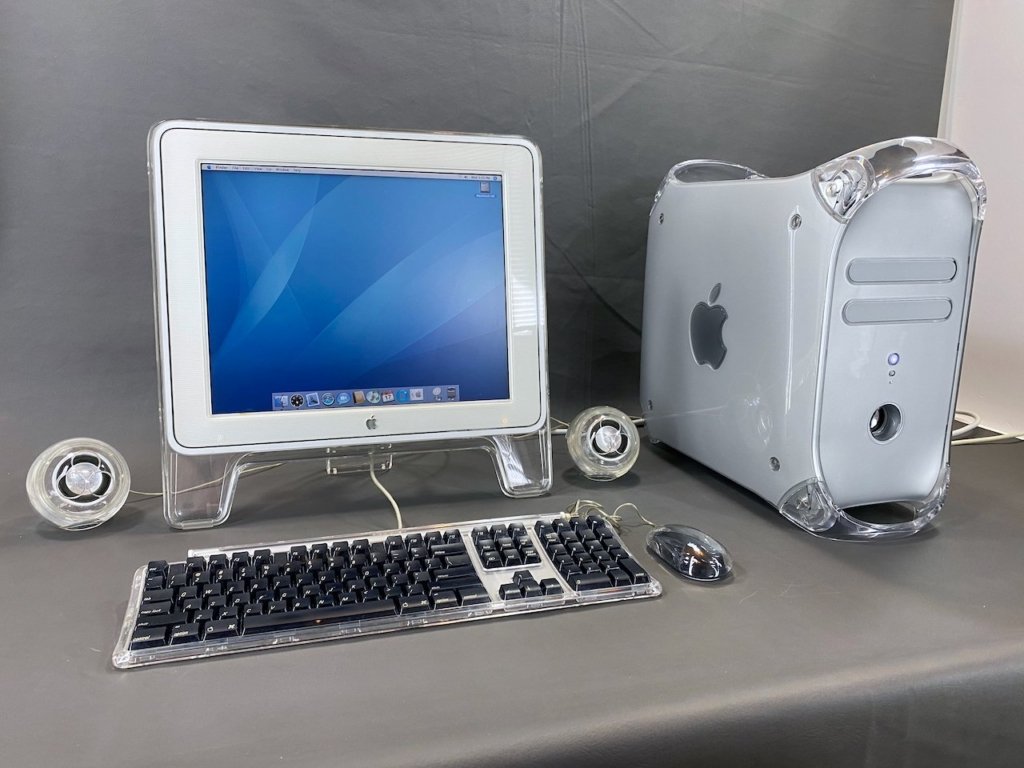In the ever-evolving landscape of personal computing, certain milestones stand out as icons of innovation. The Power Mac G4 QuickSilver, introduced by Apple in 2001 and discontinued in 2002, is one such milestone. As we reminisce about this iconic computer, let’s delve into its groundbreaking features, its impact on the industry, and its lasting legacy.
On July 18, 2001, Apple launched the Power Mac G4 QuickSilver, a pinnacle of technological prowess during its time. Priced at a competitive $1,699, this computer was part of the Power Mac G4 series, designed to push the boundaries of performance and digital media solutions.
The Power Mac G4 QuickSilver boasted a lineup of processors, including the 733 MHz, 867 MHz, and dual 800 MHz PowerPC G4 processors. Apple’s CEO, Steve Jobs, proudly declared, “These are the fastest Macs ever,” emphasizing the groundbreaking speed and power these machines brought to users.
The inclusion of the SuperDrive, a revolutionary CD-RW/DVD-R drive, became a game-changer. Capable of burning DVDs compatible with consumer DVD players, the SuperDrive was a standard feature in models priced from $2,499, making professional-quality DVD creation accessible to a wider audience.

The Power Mac G4 QuickSilver’s performance wasn’t just about raw speed; it was about utilizing cutting-edge technology. The 867 MHz and dual 800 MHz processors came equipped with Velocity Engine, providing in-processor utilization that surpassed its contemporaries. With 256K of on-chip level 2 cache running at processor speed and a generous 2 MB of level 3 backside cache per processor, these machines were geared for unparalleled efficiency.
Graphics received a boost with the inclusion of NVIDIA GeForce2 MX graphics cards as standard, delivering advanced visual experiences. The dual 800 MHz model even outpaced a 1.7 GHz Pentium IV-based PC by up to 83 percent in professional applications like Adobe’s Photoshop.
The Power Mac G4 QuickSilver wasn’t just a powerhouse under the hood; its sleek “quicksilver” enclosure housed an award-winning design. The side door swung open, providing unmatched access to expansion slots and memory – a testament to Apple’s commitment to user-friendly design.
Connectivity options were ahead of their time, with two 400 Mbps FireWire ports and two 12 Mbps USB ports, catering to the latest DV camcorders, printers, and storage devices. The inclusion of Mac OS X pre-installed brought advanced features like protected memory, preemptive multitasking, and a highly optimized BSD networking architecture.
The Power Mac G4 QuickSilver was made available in three standard configurations:
- 733 MHz Power Mac G4 – $1,699
- 256K on-chip level 2 backside cache
- 128 MB PC133 SDRAM memory
- 40 GB Ultra ATA/66 hard disk drive
- NVIDIA GeForce 2 MX graphics card with 32 MB video SDRAM
- CD-RW drive
- iDVD, iTunes, and iMovie 2 software
- 867 MHz Power Mac G4 – $2,499
- 256K on-chip level 2 backside cache and 2 MB of level 3 cache
- 128 MB PC133 SDRAM memory
- 60 GB Ultra ATA/66 hard disk drive
- NVIDIA GeForce 2 MX graphics card with 32 MB video SDRAM
- SuperDrive combination CD-RW/DVD-R
- iDVD, iTunes, and iMovie 2 software
- Dual 800 MHz Power Mac G4 – $3,499
- 256K on-chip level 2 backside cache and 2 MB of level 3 cache per processor
- 256 MB PC133 SDRAM memory
- 80 GB Ultra ATA/66 hard disk drive
- NVIDIA GeForce2 MX with TwinView graphics card and 64 MB video SDRAM
- SuperDrive combination CD-RW/DVD-R
- iDVD, iTunes, and iMovie 2 software

Customization options were vast, offering over 600,000 build-to-order configurations through The Apple Store. Users could opt for additional features such as a combination DVD-ROM/CD-RW drive, up to 1.5 GB of SDRAM, NVIDIA GeForce3 graphics card, Ultra160 SCSI drives, AirPort Base Station, AirPort Card, and audio enhancements with Harman Kardon iSub and SoundSticks, and Apple Pro Speakers.
Despite its relatively short lifespan, the Power Mac G4 QuickSilver left an indelible mark on the computing world. Its sleek design, formidable specifications, and innovative features made it a fan favorite and a symbol of Apple’s commitment to excellence.
As of today, the Power Mac G4 QuickSilver has reached the milestone of 23 years, serving as a nostalgic reminder of the era when it reigned supreme. Looking back, it’s not just a piece of technology; it’s a testament to Apple’s dedication to delivering cutting-edge products and its enduring legacy of innovation.
In a world where technology evolves at an unprecedented pace, the Power Mac G4 QuickSilver stands tall as a beacon of progress and a tribute to the visionaries at Apple who dared to redefine the possibilities of personal computing.

Power Mac G4 QuickSilver Details
| Introduced | July 18, 2001 |
| Discontinued | January 28, 2002 |
| Model Identifier | PowerMac3,5 |
| Model Number | M8493 |
| EMC | 1896 |
| Order Number | M8359LL/A (733 MHz) M8360LL/A (867 MHz) M8361LL/A (dual 800 MHz) |
| Original Price | $1,699 $2,499 $3,499 |
| Colors | QuickSilver |
| Weight | 30 Ibs. 13.607 KG |
| Dimensions | 17” H x 8.9” W x 18.4” D 43.18 cm H x 22.6 cm W x 46.73 cm D |
Power Mac G4 Mid 2001 Tech Specs
Processor
| Processor | PowerPC 7450 G4 |
| Processor Speed | 733 MHz 867 MHz Dual 800 MHz |
| Architecture | 32-bit |
| Number of Cores | 1 or 2 |
| System Bus | 133 MHz |
| Cache | 64 KB L1 256 KB backside L2 2 MB L3 (867 and Dual 800 MHz) |
Storage & Media
| Storage | 40 GB 5400 rpm 60 GB 7200 rpm 80 GB 7200 rpm |
| Media | 1 – 32x CD-RW or 24x DVD-R/CD-RW SuperDrive |
Memory
| Built-in Memory | 128 MB 256 MB |
| Maximum Memory | 1.5 GB |
| Memory Slots | 3 – PC-133 3.3v 168-pin SDRAM |
| Minimum Speed | 10 ns |
| Interleaving Support | No |
Display
| Built-in Display | None |
Graphics
| Graphics Card | NVIDIA GeForce2 MX NVIDIA GeForce2 MX with TwinView NVIDIA GeForce3 |
| Graphics Memory | 32 MB (GeForce2 MX) 64 MB (GeForce2 MX w/ TwinView and GeForce3) |
| Display Connection | 1 – VGA 1 – ADC |
| Display Modes | Dual display extended and video mirroring |
Expansion
| Expansion Slots | 4 – 33 MHz 64-bit PCI 1 – 4x AGP |
| Bays | 4 – Internal 3.5″ ATA drive bays 1 – Optical drive bay 1 – Zip 250 bay |
| Hard Drive Interface | Ultra ATA/66 (ATA-5) |
| Optical Drive Interface | EIDE (ATA-3) |
Connections
| Ethernet | 10/100/1000BASE-T (RJ-45) |
| Modem | 56k (Optional) |
| Wi-Fi | AirPort Card 802.11b (Optional) |
| Bluetooth | None |
| ADB | None |
| USB | 2 – 12 Mbps |
| Serial | None |
| SCSI | None |
| FireWire | 2 – 400 Mbps (15W total power) |
| Audio In | 1 – 3.5-mm analog input jack |
| Audio Out | 1 – 2.5-mm Apple Pro Speaker minijack 1 – 3.5-mm analog output jack 1 – Built-in speaker |
| Display | 1 – VGA 1 – ADC |
Keyboard and Mouse
| Peripherals | Apple Pro Keyboard Apple Pro Mouse |
Software
| Original OS | Mac OS 9.2 Mac OS X 10.0.4 |
| Later OS | Mac OS 9.2.1 Mac OS X 10.1 |
| Maximum OS | Mac OS X 10.4.11 (733 MHz and Dual 800 MHz) Mac OS X 10.5.8 (867 MHz) |
| Firmware | Mac OS ROM 8.3.1 |
| Bundled Software | Mac OS 9.2 or Mac OS X QuickTime iMovie 2 iDVD (requires SuperDrive) iTunes Microsoft Internet Explorer Microsoft Outlook Express Netscape Communicator FAXstf Palm Desktop Apple Hardware Test CD |
Power
| Backup Battery | 3.6 V 850 mAh Lithium (922-4028) |
| Maximum Continuous Power | 360 W |
| Line Voltage | 115 V AC (90-132 V AC) or 230 V AC (180-264 V AC) |
Further Reading and References
- Power Mac G4 (QuickSilver): Technical Specifications – Apple Support
- Apple Debuts New Power Mac G4 Line – Apple Newsroom
- Apple Ships Dual 800 MHz Power Mac G4 – Apple Newsroom
- Power Mac G4 – Wikipedia
- Quicksilver Power Mac G4 – Low End Mac
- Power Mac G4 (Quicksilver) – Mac27
- The Power Mac G4 Line – MacStories
- On the Power Mac G4 – 512 Pixels
- First Quicksilver Power Mac G4 server slips out – The Register
- Power Mac G4/ Macintosh Server G4 Service Source (PDF) – Apple Repair Manuals
Disclaimer: The data presented in this article is under continuous development and has been manually collected from various sources based on their availability. The author of this article may revise this dataset as additional research is conducted and reviewed. Please note that the information is provided “as is” and “as available” without express or implied warranties. The author cannot be held responsible for any omissions, inaccuracies, or errors in the published information. Any warranties relating to this information are hereby disclaimed.
Last updated: January 28, 2024
